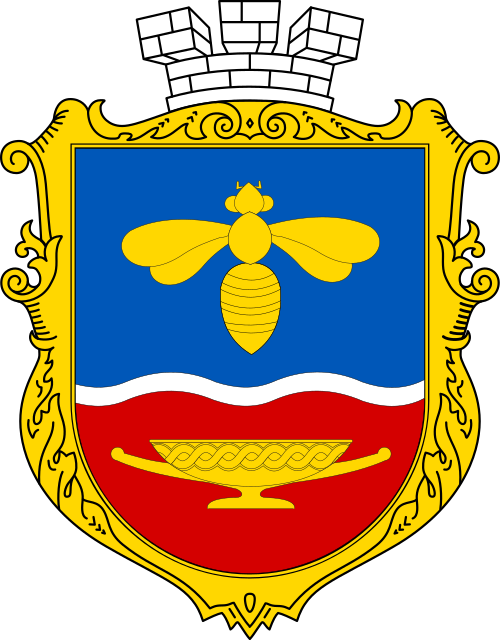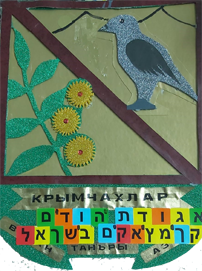
Сімферополь Coordinates: 44° 57' 25.88" N 34° 06' 38.84" E 
|
||

Сімферополь Coordinates: 44° 57' 25.88" N 34° 06' 38.84" E 
|
||
| Home | Maps | (RESERVED) | Links | Census |
NEWLY FORMED
ORGANIZATION OF KRYMCHAK JEWS FROM SIMFEROPOL IN ISRAEL
A general meeting is planned for 2 July 2021 at 10:00 AM in the
Mishkanot Daniel Ruth Hotel, 10 Ben-Zvi Road, Tel Aviv.
The meeting will be conducted in Russian with a partial Hebrew translation.

The goals are:
Sponsors: Michael Gurzhi and Michael Izmarli
Shown to the right is the organization's provisional logo adopted by Mr. Michael Izmarli
from the Crimean Congregation.
The logo text is written in both Tatar and Hebrew:
Freedom, G-d, Homeland.
The region surrounding, and including, Simferopol has a long history extending back to the Paleolithic Period (2.6 million to 12,000 BCE) during which tool-making began. The Chokurcha Cave, a short distance from Simferopol, contains evidence of Neanderthal habitation — stone tools, spearheads, rock paintings, and skeletons. More recently, the Scythian Neapolis (end of the 3rd century BCE to the 3rd century CE) was located on the outskirts of Simferopol; it was the capital of a kingdom that extended from the lower Dneiper to the Crimea. The Scythians were a nomadic people of Persian ethnicity who invaded Southern Russia and the Ukraine in the 8th century BCE. Somewhat later, the Crimean Tatars, descendants of ethnically diverse peoples, founded a town, Aqmescit (the White Mosque), on the site of Simferopol. The Crimean Tatars speak a Turkic language and practice Islam.
Aqmescit received its current name of Simferopol after the 1784 annexation of the Crimea under the auspices of Catherine II (Catherine the Great, 1762-1796) of the Russian Empire. Simferopol, in 1802, became the Taurida Government's administrative center, a political region consisting of Crimea, the lower Dnieper River, and the coasts of the Black and Azov Seas. Troops of the Tsar's army were stationed in Simferopol during the Crimean War (1854-1856). Thousands of Imperial Army troops who died during that war are buried near Simferopol.
Things turned dark in 1905. In October of that year, in response to the 1905 Russian Revolution, the Russian government promoted pogroms in an attempt to suppress the revolutionary movement. A pogrom broke out in Simferopol in which forty-two Jews were murdered. More was to come. The First World War and the Civil War that followed resulted in much disruption, suffering of the Russian people, and population migration throughout Russia. Many Jews fled to Simferopol. The city became an important Zionist center from which many Jews left for Palestine. By 1926, Jews represented 19.6% (17,364 people) of the city's population; thirteen years later the Jewish community increased to 22,791 lives — 16% of the city's residents.
The 1917 Revolution and the subsequent pogroms led Simferopol Jews to establish a self-defense force. Many Jews were elected to the local council (soviet). This did not last long. The Bolsheviks seized power in early 1918, disbanded the Jewish self-defense force, and removed Zionists from the soviet. Leftist Zionist organizations initially operated openly and then clandestinely until 1927.
During the Russian Civil War (1919-1921) White forces maintained a headquarters in Simferopol. The Red Army captured the city in November 1920. About a year later, Simferopol was anointed the capital of the Crimean Autonomous Soviet Socialist Republic. During the Second World War Nazi troops occupied Simferopol from November 1941 to April 1944 when the city was liberated by Soviet troops. As soon as the Nazis controlled the city they got down to business, slaughtering more than 22,000 residents of Simferopol — Jews, Russians, Krymchaks (an ancient Jewish Crimean community derived from Turkic-speaking adherents of Rabbinic Judaism), and Romani. Einsatzgruppen D, commanded by SS-Gruppenführer Otto Ohlendorf, alone murdered 14,300 residents of the city — mostly Jews*. Outside Simferopol, without marker or monument, is a mass grave of 14,000 Jews who were murdered by the Nazis. In Landsberg Prison on 7 June 1951, SS-Gruppenführer Otto Ohlendorf was executed for crimes against humanity for his murderous activities in southern Ukraine, the Crimea, Moldova, and the North Caucasus.
On 18 May 1944, a month after the liberation of Simferopol by the Soviet Army, Stalin ordered the Tatar population of the city, together with the entire Crimean Tatar people, to be deported to Central Asia – primarily to Uzbekistan. They would not be allowed to return to their historical land until the 1990s. During the war, Tatar men served in the Soviet Army; others were partisans fighting against the Germans in Crimea. However, other Tatar men joined the Nazi Army's Tatar Legion. Tatar religious and political leaders collaborated with the Germans during the occupation of the Crimean. The persecution of the Tatars had begun by Stalin before World War II; Stalin considered the Tatars a "suspect nation". The deportation was an excuse to justify Stalin's persecution.
Archeological evidence reveals that Jews have lived in the Crimea as early as the first century BCE. Jews, both Krymchaks and Ashkenazi, began settling in Simferopol after the Russian annexation of the Crimea in 1784. The Ashkenazi Jews had emigrated from the Pale of Settlement. Emigration from the Pale continued throughout the nineteenth century. By 1897 the Jewish population of Simferopol had reached 8,951 people, more than eighteen percent of the total population of the city. Jews worked as merchants and craftsmen, in printing houses and in tobacco factories. There were two talmud torahs, a library, a hospital, two schools and a girls' vocational school.
The name Simferopol is derived from the Greek Symferópoli which means city of common good or city of usefulness. Empress Catherine the Great required Greek names to be used in newly acquired southern territories. The city is located near the Salhir River in the south-central area of the Crimean Peninsula. It is a region subject to a humid subtropical climate. During the Ice Age, this region was free of ice, making it an attractive area for settlement.
Today there are approximately 4,200 Jews living on the Crimean Peninsula, of which about half live in Simferopol. The Jewish residents are disbursed throughout the region; they do not live in a single neighborhood. Jews are not subject to Anti-semitism; they are free to live their lives without interference. Jewish organizations function freely.
Three branches of Judaism exist in Crimea. Chabad, organized under the leadership of Rabbi Yechezkiel Lazar; Krymchaks, led by Rabbi Doron Khondo; and Reform Judaism.
The Simferopol synagogue is located at 78 Krasnoznamennaia Street. Another synagogue, Ner Tomid, currently being restored, is located at 61 Sergeev-Tsensky Street.
(source re. modern Simferopol: Michael Gurdzhi)
*There are varying figures for the number of people murdered by the Nazis. The Germans claimed that there were between 12,000 and 14,000 Jews in Simferopol in November 1941 when they entered the city. In early December of that year, Sonderkommando 11b murdered more than 10,000 Jews; they also executed about 2,500 Krymchaks. Other sources provide different murder counts — 20,600 Jews from Simferopol and the surrounding region were murdered during the 1941 - 1942 period.
|
Please contact Esther Rechtschafner with your additions, questions, corrections, or comments! webmaster: richard L. baum |
|
This page is hosted at no cost to the public by JewishGen, Inc., a non-profit corporation. If it has been useful to you, or if you are moved by the effort to preserve the memory of our lost communities, your JewishGen-erosity would be deeply appreciated. |
|
KehilaLinks Home |
JewishGen Home
|
Created: 11 March 2021
Last Modified: 05-30-2021
Copyright © 2021 Esther Rechtschafner
All Rights Reserved.